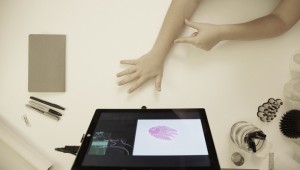Tactum Lets You Manipulate 3D Models on Your Skin

Latest News
October 2, 2015
Using a 3D printer is straightforward. Designing an object that can be printed? Not so much. 3D design requires a certain amount of specialized knowledge and experience with advanced design software. Teacher Madeline Gannon wants to lower the knowledge barrier so that more people can take advantage of 3D printing to create things.
Gannon is a researcher and a teacher at Carnegie Mellon University’s School of Architecture, and a Ph.D. candidate in Computational Design. Through her design collective, MADLAB.CC, she has developed a solution called Tactum, software that lets users create 3D print designs by touching an image projected on human skin.
The projected image can be manipulated by hand. Projecting the design on the human body has allowed Gannon to model and create jewelry and other wearable items by crafting the design to the person intended to wear it.
The solution uses a Casio XJA251 projector to extract natural gestures, and a Kinect camera. 3D printing constraints are embedded in the geometry so that every design is printable, even if the user manipulates the model significantly prior to printing.
She has also developed Reverb, which converts those designs into printable meshes.
Gannon’s first design was a custom watchband, but she hopes that Tactum can be used for customizing prosthetics and other wearable medical devices. She also wants Tactum to be adopted as a teaching tool. The goal is to make this type of design work more accessible.
“I want them to be intuitive. I want them to be easy to understand. I want to hide complexity and show abstraction,” Gannon told Popular Science.
Gannon has been named artist-in-residence at Autodesk Research, which funded Tactum’s development. She plans to further develop Tactum for medical applications during her tenure.
Source: Popular Science
Subscribe to our FREE magazine, FREE email newsletters or both!
Latest News
About the Author
Brian Albright is the editorial director of Digital Engineering. Contact him at [email protected].
Follow DE





